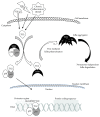Search for Novel Diagnostic Biomarkers of Prostate Inflammation-Related Disorders: Role of Transglutaminase Isoforms as Potential Candidates
- PMID: 31360119
- PMCID: PMC6652054
- DOI: 10.1155/2019/7894017
Search for Novel Diagnostic Biomarkers of Prostate Inflammation-Related Disorders: Role of Transglutaminase Isoforms as Potential Candidates
Abstract
Investigations on prostate inflammation-related disorders, including acute and chronic prostatitis, chronic pelvic pain syndrome, benign prostate hyperplasia (BPH), and prostate cancer (PCa), are still ongoing to find new, accurate, and noninvasive biomarkers for a differential diagnosis of those pathological conditions sharing some common macroscopic features. Moreover, an ideal biomarker should be useful for risk assessment of prostate inflammation progression to more severe disorders, like BPH or PCa, as well as for monitoring of treatment response and prognosis establishment in carcinoma cases. Recent literature evidence highlighted that changes in the expression of transglutaminases, enzymes that catalyze transamidation reactions leading to posttranslational modifications of soluble proteins, occur in prostate inflammation-related disorders. This review focuses on the role specifically played by transglutaminases 4 (TG4) and 2 (TG2) and suggests that both isoenzymes hold a potential to be included in the list of candidates as novel diagnostic biomarkers for the above-cited prostate pathological conditions.
Figures


Similar articles
-
Differential alternative splicing of human transglutaminase 4 in benign prostate hyperplasia and prostate cancer.Exp Mol Med. 2010 Apr 30;42(4):310-8. doi: 10.3858/emm.2010.42.4.031. Exp Mol Med. 2010. PMID: 20177144 Free PMC article.
-
Diagnostic and prognostic value of serum miR-15a and miR-16-1 expression among egyptian patients with prostate cancer.IUBMB Life. 2018 May;70(5):437-444. doi: 10.1002/iub.1733. Epub 2018 Mar 9. IUBMB Life. 2018. PMID: 29522280
-
Loss of tissue transglutaminase as a biomarker for prostate adenocarcinoma.Cancer. 2000 Jul 15;89(2):412-23. doi: 10.1002/1097-0142(20000715)89:2<412::aid-cncr29>3.0.co;2-o. Cancer. 2000. PMID: 10918174
-
The controversial relationship between benign prostatic hyperplasia and prostate cancer: the role of inflammation.Eur Urol. 2011 Jul;60(1):106-17. doi: 10.1016/j.eururo.2011.03.055. Epub 2011 Apr 9. Eur Urol. 2011. PMID: 21497433 Review.
-
Transglutaminase-2: evolution from pedestrian protein to a promising therapeutic target.Amino Acids. 2017 Mar;49(3):425-439. doi: 10.1007/s00726-016-2320-2. Epub 2016 Aug 25. Amino Acids. 2017. PMID: 27562794 Review.
Cited by
-
Exploring the Enigma of 5-ARIs Resistance in Benign Prostatic Hyperplasia: Paving the Path for Personalized Medicine.Curr Urol Rep. 2023 Dec;24(12):579-589. doi: 10.1007/s11934-023-01188-z. Epub 2023 Nov 21. Curr Urol Rep. 2023. PMID: 37987980 Review.
References
-
- Ablin R. J., Whyard T. C. Immunobiological implications of selected bioactive molecules in the prostate with a known and unknown target. In: Farnsworth W. E., Ablin R. J., editors. The Prostate as an Endocrine Gland. CRC Press; 1990. pp. 148–172.
-
- Nickel J. C., Roehrborn C. G., O’Leary M. P., Bostwick D. G., Somerville M. C., Rittmaster R. S. Examination of the relationship between symptoms of prostatitis and histological inflammation: baseline data from the REDUCE chemoprevention trial. The Journal of Urology. 2007;178(3):896–901. doi: 10.1016/j.juro.2007.05.041. - DOI - PubMed
-
- St. Hill C. A., Lutfiyya M. N. An epidemiological analysis of potential associations between C-reactive protein, inflammation, and prostate cancer in the male US population using the 2009-2010 National Health and Nutrition Examination Survey (NHANES) data. Frontiers in Chemistry. 2015;3:p. 55. doi: 10.3389/fchem.2015.00055. - DOI - PMC - PubMed
Publication types
MeSH terms
Substances
LinkOut - more resources
Full Text Sources

